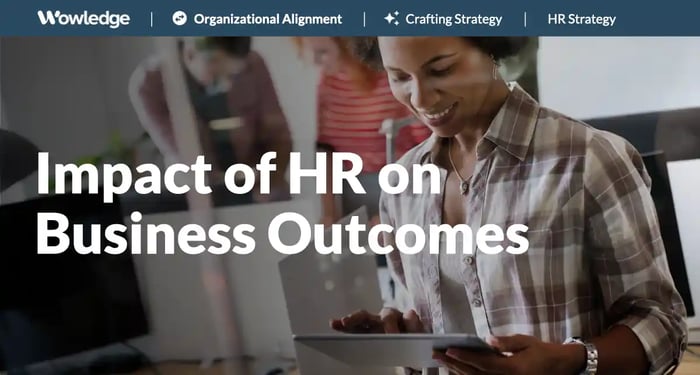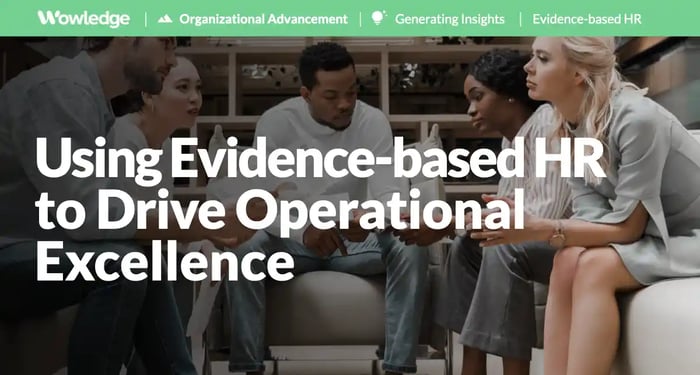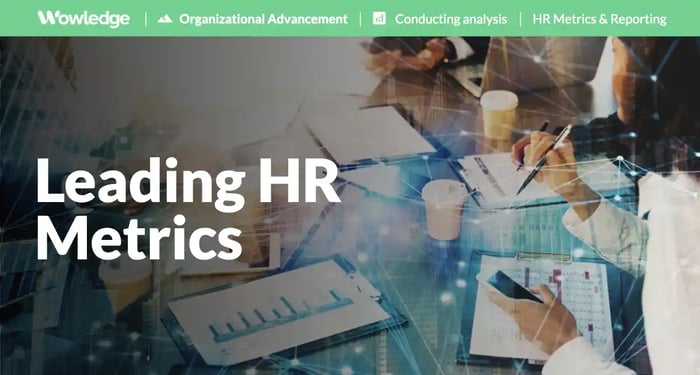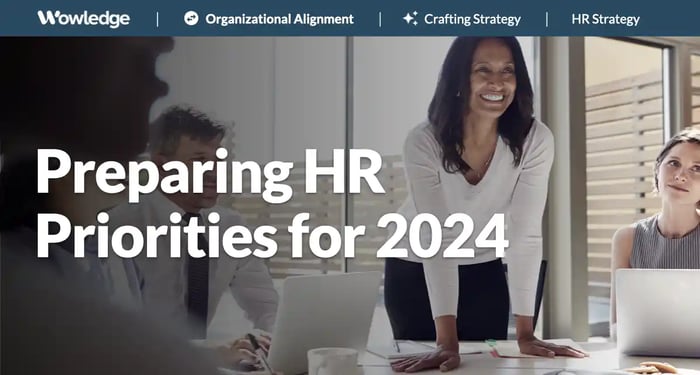The challenge of getting HR a proverbial “seat at the table” has been discussed, dissected, digested, regurgitated, dissected, and digested again and again over the years. The fact is that HR does have a seat at the executive table, as evidenced by the inclusion of CHROs, CPOs, and VPs of HR on the top leadership team of most companies. The real issue is gaining respect for the function as a significant contributor to business objectives. Frankly, earning that respect is based upon driving the impact of HR via the right mix of skills, capabilities, programs, and, most importantly, how those are deployed against company goals and objectives. That said, the “proof is in the pudding” means providing compelling and ongoing evidence of the impact of HR on the business.
As one of HR’s critical roles is to create an ecosystem where a sufficient supply of properly skilled, prepared, and productive employees are available to perform the work necessary to achieve corporate objectives, the contribution should be self-evident. Furthermore, as labor costs can account for between 15% to more than 50% or more of total business costs, the impact of HR on profitability and stakeholder return is substantial.
The issue is how HR teams can add value to the business while communicating how their myriad contributions impact decision-making.
Defining HR impact
What does it mean for HR to impact the business? Simply said, it means that HR processes, programs, practices, policies, and platforms constructively support achieving business objectives. That refers to the alignment of HR’s efforts towards specific business ends.
What that calls for, then, are clearly delineated connections and relationships between HR efforts and certain business goals or objectives. And that’s where the difficulties exist. It starts with developing HR strategies, plans, and programs unambiguously linked to supporting targeted business outcomes. It continues with tailored responses to overcoming barriers to specific business challenges. It involves valid and reliable measures demonstrating statistically significant relationships between the HR activity and the business goal or issue.
Unfortunately, as we have covered in previous blog posts, perceptions and realities stymie HR’s efforts to prove its value. Those include a range of issues that make determining and communicating the impact of HR on the business a steep hill to climb.
Key challenges faced in demonstrating HR impact
1. A fundamental disconnect between HR practices, policies, initiatives, and business outcomes
Research tells us that the most basic issue related to the impact of HR lies in the lack of direct connections between HR processes, programs, and specific business goals. Over 50% of organizations provide services and programs that are not aligned with a specific business purpose. Fewer than 15% of HR organizations can articulate how their policies, practices, or programs are designed to impact business goals.
Even worse, the HR professionals themselves are unsure of the connection. HR confidence in how their work drives or otherwise impacts specific business objectives is lower than one might hope, with less than 30% of HR professionals “very confident” that their work impacts productivity, cost avoidance, customer satisfaction, product/service quality, or revenue growth. The inability to understand how their efforts contribute to business goals and objectives is an enormous issue for HR teams. Such awareness adds much to the sense of meaningfulness of their work, reducing burnout and driving engagement.
LinkedIn reports that only 9% of surveyed companies understand which talent dimension drives organizational performance.
2. Business leaders do not understand or see the connection(s)
Many business leaders struggle to understand how HR’s efforts impact their primary business objectives. A recent study by Lattice found that only 27% of executives believe that HR impacts revenue growth (vs. 53% of HR leaders). Similar perceptions exist when executives are asked about HR’s impact on customer satisfaction (30%), cost savings (27%), and product or service quality (28%). Even employee productivity is seen by only 61% of C-Suite leaders as impacted by HR.
Perhaps more concerning is the lack of trust leaders seem to have in the broadly promoted and accepted connection between highly touted talent outcomes and improved business outcomes. For example, the same study found that only 50% of executives trust that company culture is a significant driver of business outcomes, and less than half (48%) agree that employee engagement has implications for their business results. That lack of appreciation is alarming, given the number of articles that report the opposite in esteemed and widely read journals, magazines, and websites from the top business schools, consulting firms, and business researchers.
3. Poor or limited access to data and analyses targeting the impact of HR
Issues with the required availability and expertise needed to generate useful HR impact insights are widespread and continuing to create headaches for CHROs and CPOs. LinkedIn reports that only 8% of companies in EMEA have “usable (HR) data.” The problems that limit an organization’s ability to assess and report on the impact of HR on their businesses include some significant factors, including:
- Data integrity. A common issue across HR that often comes from less effective data and analytic standards and governance practices. This often is the result of a lack of a data dictionary that defines the exact nature of each piece of information that is loaded into an HR system and a metric calculation guide that clarifies exactly how each HR measure or KPI will be calculated. Without reliable data and consistent calculations and analyses, results can be questioned, produce inconsistent results, and lose credibility for the HR team.
- Limited data access. A common issue lies in the lack of integrated systems within HR (e.g., HRIS, ATS, TMS, LMS) and across the business (e.g., ERP, vendor/production/revenue management systems) or a database that compiles data across functions and systems. Add to that the infrequency of access provided to HR analytic teams and the need to “harmonize” mixed data (e.g., from surveys, financial results, attendance data, etc.), each of which requires expert attention. Blended HR and business impact analyses are virtually impossible without those integrations, repositories, data accesses, and formatting.
- Analytic capability shortages. The shortage of HR capabilities related to statistics, analytic methods, data mining, etc., is well-established. While many companies now report having dedicated analytic teams, the breadth of skills required to conduct more advanced and sophisticated analyses often require graduate-level degrees in statistics, I/O psychology, data science, etc., are often shortcomings of these teams. Add the expertise needed to ask the “right” questions that guide those teams in the more useful analyses, often from a deep understanding of the business, representing a skill deficit.
- Separating out the impact of HR. Understanding how much a particular HR action or capability has impacted a business outcome is tricky. For example, employee engagement is driven by numerous factors such as managerial behavior, growth, and development programs offered by HR, as well as the level of company success; the extent of HR impact can be difficult to discern. On a quantitative basis, it’s often a chicken and egg problem – does great market success drive meaningful talent outcomes, or do great talent practices (and execution) drive meaningful business outcomes? Or is it a composite of the two? While research by the McKinsey Global Institute suggests that it combines great people and business management processes, it requires well-designed and advanced statistical analyses to understand the relative impact of several potential factors.

The evidence for the impact of HR is abundant
Despite the abovementioned issues, much evidence proves HR’s impact on the business. Quantitative research points to the significant impacts of various HR practices, processes, and programs on highly desirable business outcomes.
Employee engagement
Gallup has demonstrated that HR’s focus on driving higher employee engagement significantly influences organizational success, including financial, customer, retention, safety, quality, and shrinkage measures. It was found that companies with highly engaged employees had more than doubled (2X+) their likelihood of higher performance in those business outcomes. They reported 14% higher productivity, 10% higher customer satisfaction, 18% higher sales, and 23% higher profitability than organizations with low engagement.
Another report analyzed over 450 studies, demonstrating that organizations with high employee engagement produce 23% greater profitability than those with lower reported levels.
Similarly, Microsoft research found that companies that prioritized engagement not only outperformed the S&P 500 in times of economic uncertainties but also added $46,511 in market cap per employee for each added point of engagement over their peers who deprioritized engagement during those times.
Talent development and allocation
McKinsey found that companies who offer exceptional talent development opportunities through robust internal mobility, training hours, and organizational health efforts (and have strong accountability mechanisms for unit performance standards) were almost 150% more likely to place in the top tier of corporate financial performers year after year, while also enjoying half the earnings volatility that their peers experienced. This combines employee development with strong internal management practices, systems, and culture.
Another study found that companies that actively and frequently rotated high performers to their most critical strategic business priorities were over two times (2.2X) more likely to generate a higher total return to shareholders (TRS) than their peers who did not reallocate their top talent.
Employee experience (EX)
Employees with a better EX tend to be more productive, stay longer, generate more innovations, drive higher customer satisfaction, participate in more development opportunities, and stay longer. As a result, they are better prepared to handle the sales and service requirements of retail and other customer-facing organizations. Research reported in the Harvard Business Review found that those with more job rotations, longer tenure, and better-developed skills generated significantly higher sales per hour. The lower-performing stores that adopted these practices could generate a 50% increase in revenue and a 45% increase in profits per person hour.
Furthermore, Willis Towers Watson found that those companies with a robust EX strategy and program achieved a 7% difference in three-year change in gross profit margin. MIT research has found that companies in the top quartile on employee experience generate 25% higher profitability than their competitors. Finally, McKinsey reported that organizations that successfully deliver a positive employee experience are found to be 1.3 times more likely to outperform their competitors.
Organizational commitment, HR practices, and culture
A summary/meta-analysis of multiple studies covering over 8,000 companies found that the quality of HR Management practices significantly impacted organizational performance. HR’s focus on management skills, culture development, and responsive, reliable, and low-friction HR processes and practices are linked positively to quality, shrinkage, and productivity, plus lower operating expenses and higher pre-tax profits.
Great Places to Work found that its top-rated employers generated a 1,811% increase in stock prices between 1998-2022. This represents a 3.4X better return than the almost 1,000 largest companies on the FTSE Russell Index. Furthermore, in 2020, the top 100 outperformed their peers on the Russell 3000 Index on stock price growth by 16.5% (37.4% vs. 20.9%)
Aligning employee goals with the larger organization's goals contributes significantly to business outcomes. For example, research from when employee goals are well-connected to organizational goals and objectives Gartner found that they lead to a 22% bump in employee performance.
McKinsey reports that those companies with the highest “organizational health” (culture, skills and learning, motivation, etc.) plus positive management practices and employee experience, much of which HR directly drives or influences, enjoy shareholder returns 60% higher than median companies, and 200% higher than bottom-quartile performers. In a related study, Gallup found that a strong culture drives an 85% net profit increase over five years.
Finally, a study by the Boston Consulting Group examined the impact of various HR specialties/subfunctions and found strong, positive linkages between “high capability” HR functions and profit growth and margin, led primarily by talent management processes and initiatives. Those top HR function companies outperformed the lower ones by between 160% to 350% in profit growth and 120% to 160% in profit margin.
Leadership effectiveness
Effective and motivating leadership is linked to substantially higher customer ratings, profitability, quality, and productivity. HR’s leadership and management development role is at the core of enhancing their competencies, thinking, strategies, and behavior. HR programs and processes that build their capabilities are clearly tied to increased effectiveness and are designed to drive substantially improved business performance. In fact, Gallup’s research demonstrated that on average, companies with great leaders and managers generate 147% higher earnings per share than their competition.

Responding to the HR impact challenge
The keys to addressing the challenge of the impact of HR lie in three critical actions:
1. Align all strategies and initiatives with specific business outcomes
Plan all initiatives and goals to address each element of the organization’s strategic plan in a specific and well-articulated manner. Work with strategic business, operational, and finance planners and experts to address each and confirm the relationship. Plan on using analytics (see below) to assess the validity of those connections. Leverage consultative methodologies such as organization development (OD), design thinking, performance consulting, and process redesign to build business-aligned solutions and initiatives.
2. Evaluate the role of each major HR process and practice
Generate (and communicate) a joint understanding of the business purpose and linkage to the company purpose, mission, strategic direction, customer value proposition, community stakeholder agenda, etc. Conduct this analysis and exercise on each HR function, process, service, and product. Use change management strategies to build awareness and understanding of the linkages in each member of the HR team.
3. Measure what matters
Develop metrics and analyses that can be used to track, monitor, and evaluate the business impact of each key initiative, process, practice, service, and product. Do this with a primary purpose: to evaluate the extent to which each impacts the business purpose or outcomes against which they have been evaluated for alignment. Select the ones that provide the greatest insights and publish them in business leaders’ and managers’ reports and/or dashboards.
The role of measurement and analytics
The impact of HR is best assessed when measured using modern methods and technologies. That requires a certain level of capability, tools, resources, and commitment from the top. While the growth of dedicated HR (or “people”) analytics teams—43% since 2020—offers tremendous promise, the shortage of skilled professionals and other issues listed above are a continuing cause for concern. However, tremendous gains in business alignment and impact can occur by embracing a commitment to building such a capability that helps HR and business leaders better understand what is happening (and the root causes of those occurrences or trends) in the people sphere.
We have covered “Evidence-based HR (EBHR)” as an approach combining data and insights from inside and outside the organization to better understand and plan responses to new business objectives and challenges. The ability to enhance the impact of HR by relying on EBHR and combining external evidence with integrated business/HR data, statistical modeling, and predictive analyses is substantial.
Suppose the organization currently provides good, solid HR reports and dashboards on metrics of talent processes (time-to-fill, cost-per-hire, training hours-per-employee, HiPo job rotation rate, etc.) and talent outcomes (quality of hires, new skill certification rate, HiPo retention, named successor promotion rate). In that case, the analytics team is in a great position to move to the next level to quantitatively evaluate and demonstrate the impact of HR.
Where to start with HR business impact measurement?
The key to measuring HR's impact on the business is gaining access to business outcome data, which can then be used in combined HR and business data analyses. Several basic business metrics or KPIs can be used to assess the impact on an enterprise, business unit, geographic region, or function.
1) Develop basic questions (ideally in partnership with the relevant business leaders) about what or how certain HR processes and practices drive or relate to a targeted business outcome. For example, a question about why sales are higher in one team versus another or how training in Lean manufacturing supports (or degrades) productivity in a certain plant.
2) Request data with a specific timeframe and demographics that match the timeframe of the HR data. For example, company-wide sales growth for Q2, or total revenue for business unit “A” for the first six months of the year. Key business outcomes to use as a starting point can include:
- Sales
- Market share
- Revenue per employee (a good basic measure of productivity)
- Profitability (overall for business success or profit per employee (PPE) as a productivity/efficiency metric)
- Net promoter score (NPS)
- Customer retention
3) Brainstorm all HR metrics or data points that might impact the outcome – such as employee tenure, job level, certifications completed, unit turnover rate, etc. Plan on testing those as drivers or factors related to the business outcome.
4) Work with the analytics experts or team to generate an analysis of the impact or relationship of your HR metrics on each of these. Common statistical methods include correlations (which measure the strength of the relationship but not the cause) or regression analyses (which measure the extent to which one or more elements predict (or cause) the business outcome to occur). Correlations and covariance analyses (how consistently the HR practice and business outcome rise and drop together) are often easier to understand and start with, while a strong regression-based finding is often more actionable and powerful.
5) Review the results and look for statistically significant results. The statistician or data analyst can help explain how reliable and valid the results are. Significant findings can become the basis for new KPIs and drivers of future decision-making.
Relevant Practices & Tools
Understanding Business Strategies to Align the HR Direction. >
Core to the development of an HR strategy is building an understanding of the key business strategies and initiatives that must be accomplished during the term of the plan... more »
Generating More Robust Workforce Planning Insights With Advanced Statistical Analyses. >
Leveraging advanced analytics to establish the future-based likelihood of headcount gains and losses is a multi-faceted approach to emerging workforce planning... more »
Measuring Talent Outcomes vs. Processes to Increase Business Insights and Impact. >
In emerging practices, the focus shifts from process efficiency (learners per course, cost per hire) and effectiveness (% leaders completing leadership training program, time to fill)... more »
Deploying Advanced Statistical Methods to Better Assess and Predict Trends in HR Processes, Policies, and Programs. >
Deploying advanced methods involves moving from descriptive or basic mathematical metrics (sums, averages, percentages, medians, etc.) to more sophisticated techniques... more »
The HR Business Challenge Goal Conversion Tool: Translate Identified Challenges into Clear and Distinct HR Goals. >
This tool is used in a sequence of analyses that convert key business objectives, external, and internal environmental scans into HR challenges that can subsequently be converted... more »
About Wowledge
Wowledge is the expert-driven platform for lean teams building strategic HR programs. Members enjoy access to up-to-date best practices, step-by-step guides, tools, templates, and insights to accelerate the design and implementation of all key HR programs and processes.
Since each organization has unique characteristics, needs, and aspirations, Wowledge's practices are developed utilizing an exclusive stage-based approach – from Core to Advanced to Emerging – that reflects distinct levels of sophistication to meet our members where they are.
Build strategic HR programs with refreshingly easy-to-follow best practices.
Get started for FREE! Learn more.










